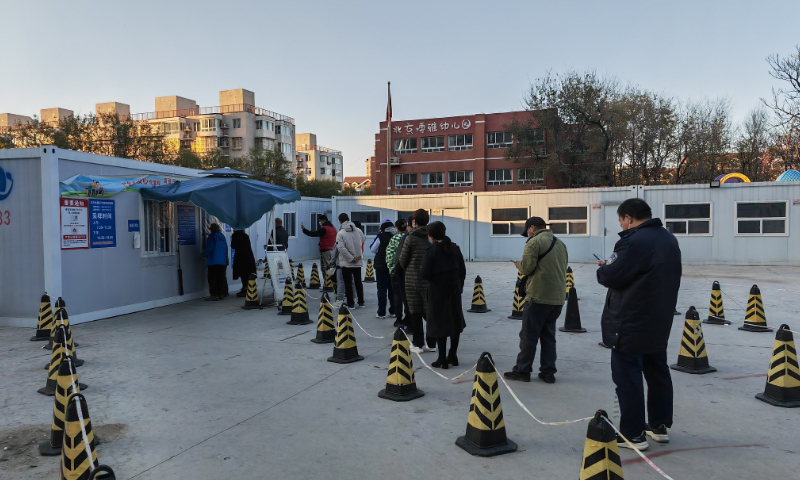
Residents in Beijing line to take nucleic acid tests on November 15, 2022. Photo: VCG
When there is no outbreak, no venue should be identified as risk area and mass nucleic acid testing should not be carried out, according to the latest guidelines released by the joint prevention and control mechanism team of the State Council on Monday in a move to further optimize the country's anti-epidemic measures amid surging cases.
The mechanism team outlined four documents with detailed regulation on nucleic acid testing, classification of risk areas, home quarantine and home health monitoring, which experts believed are supplementary regulations to the newly issued
20 optimized COVID-response measures.
According to one of the documents focusing on nucleic acid testing, local authorities should not roll out mass nucleic acid testing when there is no outbreak. Instead, they should closely follow the ninth edition of the country's epidemic prevention and control plan to focus on key populations.
High risk groups, according to the document, include those who have direct contact with international arrivals - including drivers and attendants of cross-border vehicles, cleaning staff and customs officers, working staff at centralized quarantine sites, designated hospitals and fever clinics of normal hospitals. People from these groups should accept nucleic acid testing once a day.
Meanwhile, people who go to the hospitals should undergo nucleic acid testing in a timely manner if they show suspected symptoms including cough, fever and diarrhea, are recovered COVID-19 patients, or are employed in high-risk industries or show signs of pneumonia without clear cause, according to the document.
Hospitalized patients and accompanying personnel should also accept testing. As should patients who show signs of severe respiratory infection, the document noted.
Antigen testing can also be conducted together with nucleic acid testing to detect outbreaks as soon as possible.
Key venues including kindergarten and nursing homes should follow local normal epidemic prevention and control measures to observe the health conditions of staff and accept periodic inspection. One time of all-personnel nucleic acid testing should be conducted when more than one local COVID-19 cases are reported, according to the document.
People traveling from high-risk areas to other locations should undergo health quarantine at home for seven days. They should not leave home and should accept nucleic acid testing on once in two days.
Close contacts and international arrivals should accept nucleic acid testing twice in three days after they are released from centralized quarantine to home.
As to the standards of the classification of risk areas, another document regulated that high risk areas should be designated to specific building and should be revoked if no new infection is discovered in five days.
Areas in the same district, county or city with the high-risk area would be identified as low-risk areas, the document said.
Specific locations should not be designated as risk areas if confirmed cases or asymptomatic cases are discovered during centralized quarantine, home quarantine, close-loop management but are evaluated as posing no risk to the community or families outside their range of activities.
They should neither be identified as risk areas if a discharged patient is tested COVID-19 positive but pose no risk of spreading virus or an international arrival's Ct value is more than 35, according to the document.
Global Times




